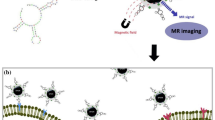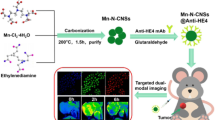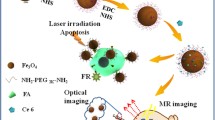Abstract
We designed a new nanoprobe—NPAPF-Fe3O4 NPs (about 150 nm)—with magnetic targeting fluorescence/magnetic resonance dual-mode imaging by using the combination of an AIE dye NPAPF (bis(4-(N-(2-naphthyl)phenylamino) phenyl)-fumaronitrile) and Fe3O4 NPs. The size of the NPAPF-Fe3O4 NPs was about 150 nm. This design successfully overcame the fluorescence quenching of the organic fluorescent dyes in the presence of metallic materials, which could be used for imaging applications. Under the premise of ensuring fluorescence imaging, we introduced the magnetic resonance imaging contrast agent Fe3O4 NP with higher spatial resolution and high sensitivity, and also a magnetic field–assisted targeting effect. After the surface modification, the NPAPF-Fe3O4 NPs showed good dimensional stability, biocompatibility, and biosafety, and had a longer blood circulation time in vivo. The NPAPF-Fe3O4 NPs were used to study the in vivo and in vitro fluorescence imaging and in vitro magnetic resonance imaging. The results showed that the fluorescence intensity of NPAPF-Fe3O4 NPs was lower than that of NPAPF NPs at the same concentration in cell imaging experiments. However, due to the appropriate Fe3O4 NP doping ratio, better fluorescence imaging could be achieved by NPAPF-Fe3O4 NP both in vitro and in vivo. In addition, in vitro magnetic resonance imaging showed a linear relationship between the 1/T2 of NPAPF-Fe3O4 NPs and the concentration of Fe, which was a T2 contrast agent capable of magnetic resonance imaging.
Graphical Abstract










Similar content being viewed by others
References
Siegel RL, Miller KD, Fuchs HE, Jemal A (2022) Cancer statistics, 2022. CA Cancer J Clin 72:7–33. https://doi.org/10.3322/caac.21708
Saxby K, Nickson C, Mann GB et al (2021) Moving beyond the stage: how characteristics at diagnosis dictate treatment and treatment-related quality of life year losses for women with early stage invasive breast cancer. Expert Rev Pharm Out 21:847–857. https://doi.org/10.1080/14737167.2021.1857735
Lee JY, Song HS, Choi JH, Hyun CL, Lee SA, Choi JH, Lee S (2019) Detecting synchronous parathyroid adenoma and false-positive findings on Technetium-99m MIBI single photon-emission computed tomography/computed tomography. Diagnostics 9:57. https://doi.org/10.3390/diagnostics9020057
Saladino GM, Vogt C, Li YY et al (2021) Optical and X-ray fluorescent nanoparticles for dual mode bioimaging. ACS Nano 15:5077–5085. https://doi.org/10.1021/acsnano.0c10127
Cheng CL, Chan MH, Feng SJ, Hsiao M, Liu RS (2021) Long-term near-infrared signal tracking of the therapeutic changes of glioblastoma cells in brain tissue with ultrasound-guided persistent luminescent nanocomposites. ACS Appl Mater Interfaces 13:6099–6108. https://doi.org/10.1021/acsami.0c22489
Ordonez AA, Carroll LS, Abhishek S et al (2019) Radiosynthesis and PET bioimaging of Br-76-Bedaquiline in a murine model of tuberculosis. ACS Infect Dis 5:1996–2002. https://doi.org/10.1021/acsinfecdis.9b00207
Song RG, Ruan ML, Dai J, Xue W (2021) Biomimetic magnetofluorescent ferritin nanoclusters for magnetic resonance and fluorescence-dual modal imaging and targeted tumor therapy. J Mater Chem B 9:2494–2504. https://doi.org/10.1039/d0tb02175j
Schima W, Mukerjee A, Saini S (1996) Contrast-enhanced MR imaging. Clin Radiol 51:235–244. https://doi.org/10.1016/S0009-9260(96)80339-4
Wang CB, Yan CL, An L, Zhao HF, Song SL, Yang SP (2021) Fe3O4 assembly for tumor accurate diagnosis by endogenous GSH responsive T-2/T-1 magnetic relaxation conversion. J Mater Chem B 9:7734–7740. https://doi.org/10.1039/d1tb01018b
Ribeiro M, Boudoukhani M, Belmonte-Reche E et al (2021) Xanthan-Fe3O4 nanoparticle composite hydrogels for non-invasive magnetic resonance imaging and magnetically assisted drug delivery. ACS Appl Nano Mater 4:7712–7729. https://doi.org/10.1021/acsanm.1c00932
Wang S, Shen HL, Mao QL et al (2021) Macrophage-mediated porous magnetic nanoparticles for multimodal imaging and postoperative photothermal therapy of gliomas. ACS Appl Mater Interfaces 13:56825–56837. https://doi.org/10.1021/acsami.1c12406
Li XM, Zhao DY, Zhang F (2013) Multifunctional upconversion-magnetic hybrid nanostructured materials: synthesis and bioapplications. Theranostics 3:292–305. https://doi.org/10.7150/thno.5289
Jing LH, Ding K, Kershaw SV, Kempson IM, Rogach AL, Gao MY (2014) Magnetically engineered semiconductor quantum dots as multimodal imaging probes. Adv Mater 26:6367–6386. https://doi.org/10.1002/adma.201402296
Liu XL, Jiang H, Ye J et al (2016) Nitrogen-doped carbon quantum dot stabilized magnetic iron oxide nanoprobe for fluorescence, magnetic resonance, and computed tomography triple-modal in vivo bioimaging. Adv Funct Mater 26:8694–8706. https://doi.org/10.1002/adfm.201603084
Yi ZG, Lu W, Liu HR, Zeng SJ (2015) High quality polyacrylic acid modified multifunction luminescent nanorods for tri-modality bioimaging, in vivo long-lasting tracking and biodistribution. Nanoscale 2:542–550. https://doi.org/10.1039/c4nr05161k
Mao FX, Wen L, Sun CX et al (2016) Ultrasmall biocompatible Bi2Se3 nanodots for multimodal imaging-guided synergistic radiophotothermal therapy against cancer. ACS Nano 10:11145–11155. https://doi.org/10.1021/acsnano.6b06067
Jares-Erijman EA, Jovin TM (2003) FRET imaging. Nat Biotechnol 21:1387–1395. https://doi.org/10.1038/nbt896
Liu JZ, Lam JWY, Tang BZ (2009) Acetylenic polymers: syntheses, structures, and functions. Chem Rev 109:5799–5867. https://doi.org/10.1021/cr900149d
Yadav P, Prajitha KP, Dhaware V, Subramani M, Joy P, Asha SK, Shanmuganathan K (2020) Dual responsive cellulose microspheres with high solid-state fluorescence emission. Colloid Surf A 591:124510. https://doi.org/10.1016/j.colsurfa.2020.124510
Luo JD, Xie ZL, La JWY et al (2001) Aggregation-induced emission of 1-methyl-1,2,3,4,5-pentaphenylsilole. Chem Commun 18:1740–1741. https://doi.org/10.1039/b105159h
Shao AD, Xie YS, Zhu SJ et al (2015) Far-red and near-IR AIE-active fluorescent organic nanoprobes with enhanced tumor-targeting efficacy: shape-specific effects. Angew Chem 54:7275–7280. https://doi.org/10.1002/anie.201501478
Yan LL, Zhang Y, Xu B, Tian WJ (2016) Fluorescent nanoparticles based on AIE fluorogens for bioimaging. Nanoscale 8:2471. https://doi.org/10.1039/c5nr05051k
Lou XD, Zhao ZJ, Tang BZ (2016) Organic dots based on AIEgens for two-photon fluorescence bioimaging. small 12:6430–6450. https://doi.org/10.1002/smll.201600872
Cao QY, Jiang RM, Liu MY et al (2017) Preparation of AIE-active fluorescent polymeric nanoparticles through a catalyst-free thiol-yne click reaction for bioimaging applications. Mater Sci Eng C 80:411–416. https://doi.org/10.1016/j.msec.2017.06.008
Wan Q, Huang Q, Liu MY, Xu DZ, Huang HY, Zhang XY, Wei Y (2017) Aggregation-induced emission active luminescent polymeric nanoparticles: non-covalent fabrication methodologies and biomedical applications. Appl Mater Today 9:145–160. https://doi.org/10.1016/j.apmt.2017.06.004
Qin W, Alifu N, Cai YJ et al (2019) Synthesis of an efficient far-red/near-infrared luminogen with AIE characteristics for in vivo bioimaging applications. Chem Commun 55:5615–5618. https://doi.org/10.1039/c9cc02238d
Cai XL, Liu B (2020) Aggregation-induced emission: recent advances in materials and biomedical applications. Angew Chem Int Ed 59:9868–9886. https://doi.org/10.1002/anie.202000845
Xiao XY, Cai H, Huang QR et al (2023) Polymeric dual-modal imaging nanoprobe with two-photon aggregation-induced emission for fluorescence imaging and gadolinium-chelation for magnetic resonance imaging. Bioact Mater 19:538–549. https://doi.org/10.1016/j.bioactmat.2022.04.026
Wang LY, Huang MY, Tang H, Cao DR, Zhao Y (2019) Fabrication and application of dual-modality polymer nanoparticles based on an aggregation-induced emission-active fluorescent molecule and magnetic Fe3O4. Polymers 11:220. https://doi.org/10.3390/polym11020220
Owens EA, Henary M, Fakhri GE, Choi HS (2016) Tissue-specific near-infrared fluorescence imaging. Acc Chem Res 49:1731–1740. https://doi.org/10.1021/acs.accounts.6b00239
Hu XW, Dong XC, Lu Y, Qi JP, Zhao WL, Wu W (2017) Bioimaging of nanoparticles: the crucial role of discriminating nanoparticles from free probes. Drug Discov Today 22:382–387. https://doi.org/10.1016/j.drudis.2016.10.002
Raj DBTG, Khan NA (2018) Surface functionalization dependent subcellular localization of superparamagnetic nanoparticle in plasma membrane and endosome. Nano Converg 5:4. https://doi.org/10.1186/s40580-018-0136-3
Funding
This work is financially supported by the Chinese Academy of Sciences Program (ZDKYYQ20180003), the Youth Innovation Promotion Association, and the Chinese Academy of Sciences (Grant No. 2019321).
Author information
Authors and Affiliations
Corresponding author
Ethics declarations
Conflict of interest
The authors declare that they have no conflict of interest.
Additional information
Publisher’s note
Springer Nature remains neutral with regard to jurisdictional claims in published maps and institutional affiliations.
Rights and permissions
Springer Nature or its licensor (e.g. a society or other partner) holds exclusive rights to this article under a publishing agreement with the author(s) or other rightsholder(s); author self-archiving of the accepted manuscript version of this article is solely governed by the terms of such publishing agreement and applicable law.
About this article
Cite this article
Nan, X., Zuo, J., He, L. et al. Application of magnetic targeted fluorescence/magnetic resonance dual-modal imaging in cancer diagnosis. J Nanopart Res 25, 61 (2023). https://doi.org/10.1007/s11051-023-05715-4
Received:
Accepted:
Published:
DOI: https://doi.org/10.1007/s11051-023-05715-4




